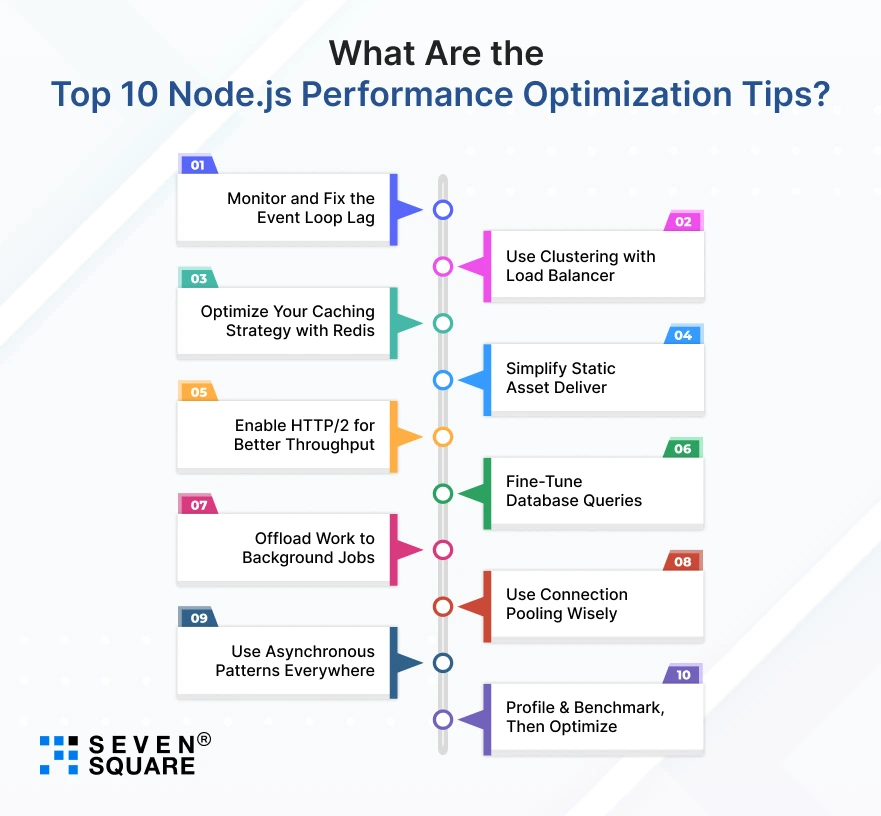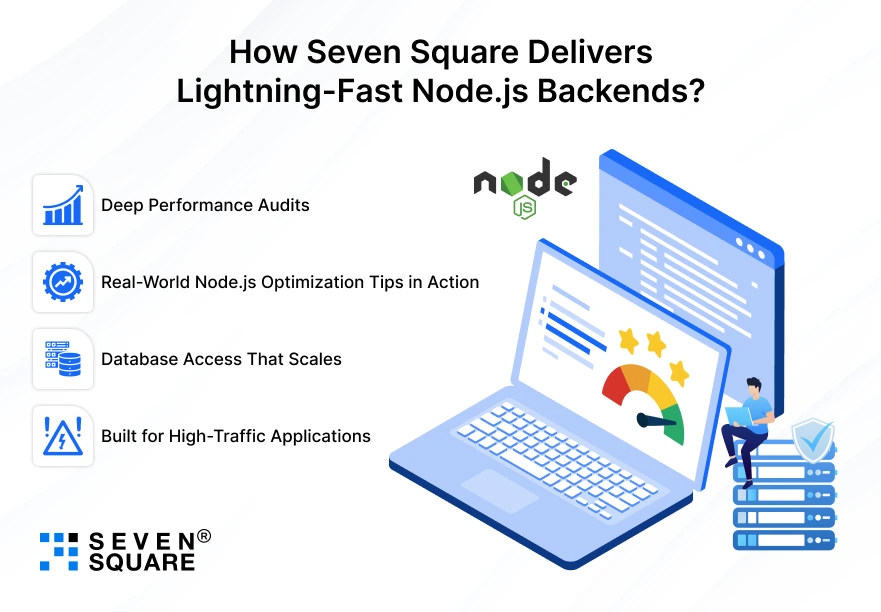You’ve got users. You’ve got balance.
But every time traffic spikes, your Node.js app slows or, worse, crashes.
Happens a Lot?
We’ve seen this too often. One client came to us after a product launch that tanked their backend.
Their Node.js server was overwhelmed, their event loop was jammed, and Redis wasn’t doing its job. The worst part? Their users didn’t stick around to wait.
We’ve built and scaled Node.js applications for fast-growing startups, enterprise platforms, and everything in between.
Whether its ecommerce, logistics, healthcare, or SaaS, we’ve helped clients optimize their Node.js performance for millions of users without sacrificing speed or stability.
So here’s our experience-backed blog about the top 10 proven Node.js Performance Tips so that your app can handle high traffic.
If you are looking for NodeJs performance optimization tips, then you are at the right place.
Is Your Node.js App Slowing Down When It Matters Most?
Imagine your campaign goes live, thousands of users flood in, but instead of orders or signups, you get complaints and timeouts.
Your app isn’t broken; it just wasn’t built for high-traffic Node.js performance.
Most businesses focus on features, not performance. Until it’s too late.
The good news? Performance optimization in Node.js isn’t about rewriting your whole app.
It’s about smart changes that scale.
Explore the top features of NodeJS 24.
What Slows Down a Node.js App? (That You’re Probably Ignoring)
Here’s the truth: Performance bottlenecks rarely come from the obvious places.
Founders often think adding more servers or rewriting in another language will fix performance.
But 90% of the time, its everyday things like a poorly cached response, a slow DB query, or blocking the event loop that sabotage your app’s ability to handle high traffic.
Let’s see what’s draining your Node.js app’s performance under pressure:
- Hidden Event Loop Bottlenecks: In production, event loop latency in Node.js under load slows when sync functions or heavy logic block the single-threaded loop.
- Business Logic That Does Too Much: We’ve seen apps trying to do all logic inside the API layer. That’s how you end up needing horizontal scaling before it’s necessary.
- One Big App, No Boundaries: The more features you stack into a single Node.js app, the more fragile and bloated it gets. We’ve seen product teams scaling users but not their architecture.
What Are the Top 10 NodeJs Performance Optimization Tips?

Are you struggling with a slow Node.js app under heavy traffic?
Go through these 10 proven Node.js performance optimization tips. With these tips, you can build faster, smarter, and more efficient Node.js systems.
1. Monitor and Fix the Event Loop Lag
Your Node.js app’s performance is only as good as its event loop. When it’s blocked, everything suffers as APIs slow down, UIs freeze, and users are disturbed.
How to fix it:
- Use tools like clinic.js, prom-client, or the eventLoopUtilization() API to identify lag.
- Move CPU-bound tasks (e.g., image resizing, encryption) to worker_threads or background services.
- Avoid blocking operations and watch out for poorly written loops or synchronous code.
Why it matters: Reducing event loop latency in Node.js under load improves response times and keeps the app usable under pressure.
2. Use Clustering with Load Balancer
Node.js runs single-threaded by default. That means only one CPU core gets used, no matter how powerful your server is.
Clustering unlocks the full potential.
How to fix it:
- Use Node’s built-in cluster module or production-grade process managers like PM2.
- Combine with Nginx or HAProxy to load balance requests across multiple Node.js workers.
- Set up sticky sessions if needed for stateful operations.
Why it matters: With clustering and a load balancer, you get horizontal scalability that handles traffic surges effortlessly.
3. Optimize Your Caching Strategy with Redis
Every millisecond counts under heavy load. Smart caching reduces load on your database and speeds up repeat requests.
How to fix it:
- Use Redis for session storage, query results, or entire rendered views.
- Set intelligent TTLs and invalidate cache on relevant updates.
- Avoid caching dynamic or user-specific content without caution.
Why it matters: A tuned Redis cache can handle thousands of reads per second, preventing bottlenecks and improving throughput.
4. Simplify Static Asset Delivery
Your API is for business logic, not file delivery. Let other tools handle static files.
How to fix it:
- Offload static assets to a CDN like Cloudflare, CloudFront, or Fastly.
- Enable compression via Gzip or Brotli.
- Add cache-control headers for long-term caching.
Why it matters: Offloading improves asset delivery speed and frees your Node.js app for core API tasks.
5. Enable HTTP/2 for Better Throughput
Still using HTTP/1.1? You’re missing out on multiplexing, header compression, and faster TLS negotiation, all crucial under load.
How to fix it:
- Upgrade to HTTP/2 using the built-in http2 module or reverse proxies.
- Combine with CDN providers that support HTTP/2 or HTTP/3.
- Monitor using Lighthouse and real-user metrics.
Why it matters: HTTP/2 improves response concurrency and reduces page load times, especially for apps with lots of assets.
6. Fine-Tune Database Queries
Your database isn’t slow; your queries are. Even the fastest backend can stall if the DB is misused.
How to fix it:
- Index columns used in WHERE, JOIN, and ORDER BY.
- Avoid nested SELECTs and N+1 queries.
- Use EXPLAIN to profile PostgreSQL or MongoDB queries.
- Consider reading replicas and caching layers for scale.
Why it matters: Query optimization reduces latency and increases throughput without scaling hardware.
7. Offload Work to Background Jobs
Every second counts in a high-traffic app. Offload anything that doesn’t need to happen in real-time.
How to fix it:
- Use job queues like Bull, Bee-Queue, or Agenda for tasks like email, logs, and notifications.
- Move image processing, analytics, and reporting to workers.
- Monitor queue latency and retry logic.
8. Use Connection Pooling Wisely
Every new DB connection costs time and memory. Pooling lets you reuse connections smartly.
How to fix it:
- Use drivers that support pooling: pg-pool, mongoose, or mysql2.
- Set limits on max/min connections based on server memory.
- Monitor and tune for idle connection timeouts.
Why it matters: Connection pooling improves efficiency and helps prevent database overload under stress.
9. Use Asynchronous Patterns Everywhere
Synchronous functions block everything, bad news in a concurrent environment.
How to fix it:
- Always use async/await or .then() with Promises.
- Refactor sync functions like fs.readFileSync() to their async versions.
- Use Promise.all or async batching for parallelism.
Why it matters: Async patterns keep the event loop responsive and scale-friendly.
10. Profile & Benchmark, Then Optimize
You can’t fix what you don’t measure. Smart teams test under real conditions.
How to fix it:
- Use tools like autocannon, artillery, and Chrome’s DevTools profiler.
- Benchmark before and after every major code change.
- Simulate traffic using wrk, JMeter, or custom scripts.
Why it matters: Objective data prevents premature optimization and shows exactly where bottlenecks live.
If you implement these Node.js performance optimization tips, then you can have a scalable NodeJs app that performs at its full potential.
How Seven Square Delivers Lightning-Fast Node.js Backends?

At Seven Square, we build fast, scalable Node.js systems that thrive under pressure.
Whether you’re scaling a high-traffic SaaS, marketplace, or on-demand platform, our team of backend experts turns bottlenecks into breakthroughs.
Here’s how we make that happen:
- Deep Performance Audits: We pinpoint critical backend issues from event loop latency in Node.js under load to inefficient DB queries before they become scaling nightmares.
- Real-World Node.js Optimization Tips in Action: We apply proven Node.js performance optimization tips according to your product’s architecture, not generic “best practices.”
- Database Access That Scales: We know how to optimize Node.js database access under pressure, whether you’re running PostgreSQL, MongoDB, or distributed data stores.
- Built for High-Traffic Applications: We’ve optimized real systems handling millions of requests like ecommerce checkouts, logistics APIs, and real-time dashboards.
Want to Optimize NodeJs App? Contact Us Now!
Smart Node.js Optimization Wins at Scale
Building a fast Node.js app is easy. Keeping it fast under real-world traffic, that’s where smart engineering shows up.
Whether it’s fixing event loop latency in Node.js under load, setting the best Redis caching strategy for high-traffic flows, or learning how to optimize Node.js database access under pressure, these performance tips are survival skills for serious apps.
Our Node.js performance optimization tips come from doing, not guessing.
If you’re planning for scale or facing slowdowns now, remember: backend speed isn’t a luxury, it’s your user experience.
FAQs
- To improve Node.js performance under load, optimize the event loop, use non-blocking I/O, implement the best Redis caching strategy, enable HTTP/2, and scale using clustering or load balancers like NGINX or HAProxy.
- Proper database optimization and modular code design also boost performance significantly.
- Use connection pooling, parameterized queries, and async database drivers. Avoid N+1 query issues and always profile slow queries.
- Caching responses and reducing query frequency also help Node.js scale under heavy traffic.
- Yes. Node.js is best to handle I/O-heavy workloads with its non-blocking architecture.
- With proper optimization, event loop tuning, Redis caching, and clustering, it performs well even under high traffic.
- Use tools like New Relic, PM2, AppSignal, or Node Clinic. Monitor event loop delay, CPU usage, memory, and response time.
- Real-time monitoring is critical to catch bottlenecks before they affect user experience.